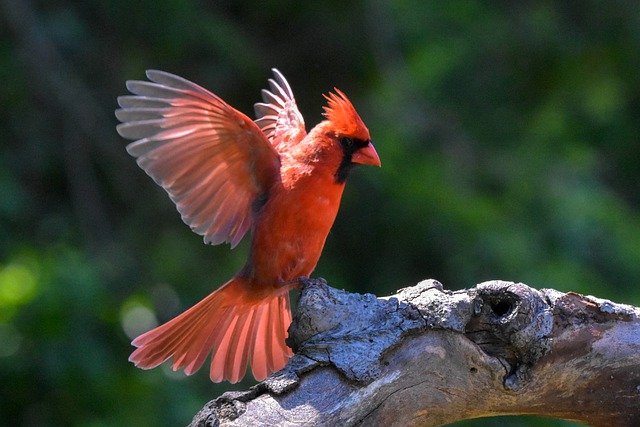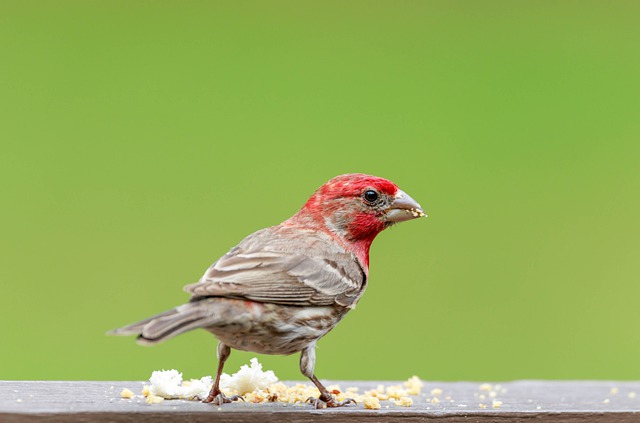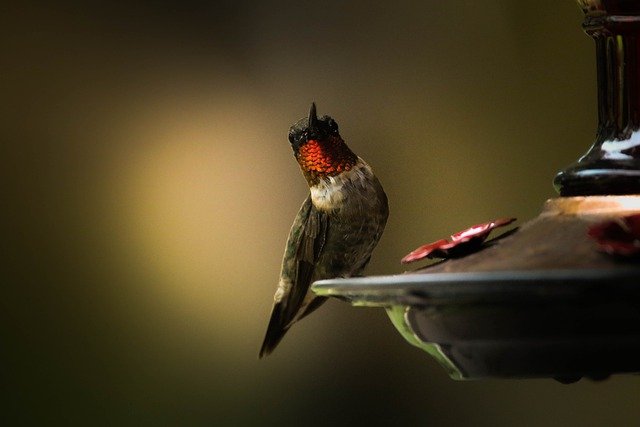Red birds can be found all across Oklahoma if you know where to look and what to look for. In this article I wil be going over 7 unique red birds that you can look out for within Oklahoma the next time you go out.
- Northern Cardinal
- House Finch
- Red Headed Woodpecker
- Ruby Throated Hummingbird
- Summer Tanager
- Scarlet Tanager
- Red Bellied Woodpecker
7 Red Birds In Oklahoma
1. Northern Cardinal (Cardinalis Cardinalis)

- Size: 21 – 23cm
- Weight: 42 – 48 grams
- Wingspan: 30 – 35cm
These cardinals can be found in Oklahoma throughout the year as it’s one of their many permenant residencies.
Northern cardinals are recognised by their mohawk-like head feathers, red exterior and beak with elements of black across the face. Females also have elements of red on their beaks and their body but, in smaller amounts, with the majority of their plumage a light brown color.
These cardinals can be found in woodlands, gardens, shrublands, wetlands and backyards if the sugar water or seeds in the feeders satisfy their taste buds.
As for the food they eat, it consists of small insects like beetles, true bugs, grasshoppers, caterpillars, ants, flies, spiders, centipedes, and snails. Seeds of weeds, berries among other smaller fruits are part of their diet too.
Northern cardinals are known to live for around 15 years in the wild although the actual number probably a lot less.
2. House Finch (Haemorhous Mexicanus)

- Size: 12.5 – 15cm
- Weight: 19 – 22 grams
- Wingspan: 20 – 25cm
These finches can be found in central Oklahoma year round whilst some may creep into other ranges within the state.
House finches have a red and brown plumage with their body mostly light brown and the head made up of a gradient red color with hints of brown. Females on the other hand are mostly brown with hints of black on their wings and back.
As for where you can find house finches, the number of habitats they stay within are quite vast ranging from dry desert, desert grassland, chaparral, oak savannah, streamsides, and open coniferous forests at elevations below 6,000 feet.
If the food is to their liking, like black sunflower seeds, these little birds will on occasion make their way to a feeder set out by a citizen. Other than seeds house finches also eat small insects like aphids as well as fruits and berries.
In the wild, house finches are known to live for around 10 years whilst captive finches can live upwards of 12 years.
3. Red Headed Woodpecker (Melanerpes Erythrocephalus)

- Size: 19 – 25cm
- Weight: 56 – 97 grams
- Wingspan: 40 – 45cm
These red headed woodpeckers can be found in Oklahoma all throughout the year as it’s one of their permanent residencies in north Ameirca.
Red headed woodpeckers are recognised by their red head and their black and white body and wings.
These woodpeckers tend to spend the majority of their time in groves, farm country, orchards, shade trees in towns, large scattered trees where you can find them in forest edges, orchards, open pine woods and the groves of taller trees.
A red headed woodpeckers diet consists of a wide variety of insects which includes spiders, earthworms, different types of nuts, seeds, berries along with other fruits. Sometimes these peckers may even eat small rodents or the contents of another birds eggs.
As for their lifespan, red headed woodpeckers have been known to live up to 10 years in the wild.
4. Ruby Throated Hummingbird (Archilochus Colubris)

- Size: 7 – 9cm
- Weight: 2 – 6 grams
- Wingspan: 8 – 11cm
Ruby throated hummingbirds can be found in Oklahoma throughout March – July, which coincides with the months they happen to breed. You can also find them migrating through the state further west.
A ruby throated hummingbird can be recognised by their plumage that is red, white and green. Their throat is the stand out red part, its breast/stomach white in color and their wings and back an emerald green color. Females aren’t nearly as adventurous with their color scheme being mostly white and green.
As for what they eat, it ranges from small insects, fruits, sugar water from feeders, tree sap and of course the nectar produced by blooming flowers.
Ruby throated hummingbirds tend to stay near environments with flowerbeds as these birds have a very strong metabolism that requires them to feed multiple times per hour. Therefore, you can find them in fields, parks, backyards, and open clearings in forests.
As for how long these tiny little hummingbirds can live for, it’s known to be around 3 – 5 years on average with the longest recorded lifespan just short of 7 years.
5. Summer Tanager (Piranga Rubra)

- Size: 15 – 18cm
- Weight: 27 – 31 grams
- Wingspan: 28 – 30cm
Summer tanagers, as their name would suggest, can be in eastern and central Oklahoma when they happen to breed, which would include the summer months.
Male summer tanagers are recognised by their almost entirely red plumage with a grayish/silver beak. Females on the other hand are almost entirely yellow.
Summer tanagers are usually found within tropical forests of tall trees with an open canopy and mostly prefer to stay in lower elevations. They can reside within habitats that are 1800 meters above sea level too.
These tanagers mostly eat small insects like bees and wasps but, will also consume berries and smaller fruits foraged from backyards, parks among other environments rich with these food sources.
On average summer tanagers are known to live for around 5 years in the wild.
6. Scarlet Tanager (Piranga Olivacea)

- Size: 16 – 19cm
- Weight: 27 – 32 grams
- Wingspan: 25 – 30cm
These tanagers will generally make their migratory passage through the state, which will be prevalent on the eastern side of the state.
Scarlet tanagers are recognised by their scarlet plumage, black wing and triangular silver/gray beak. Females are actually different in color to their male counterparts where their plumage is green with black wings.
These tanagers can be found within deciduous forest where oak maple, beech, and other trees are common. They also stay within mixed pine-oak woods, and occasionally in coniferous woods dominated by pine or hemlock.
As for what scarlet tanagers eat, it mostly consists of insects like caterpillars, moths, beetles, wasps, bees, aphids, berries and small fruits.
Scarlet tanagers can live up to 12 years in the wild although the actual lifespan for most scarlets will likely be far lower.
7. Red Bellied Woodpecker (Melanerpes Carolinus)

- Size: 22.8 – 26.7cm
- Weight: 56 – 97 grams
- Wingspan: 38 – 46cm
Red bellied woodpeckers can be found in Oklahoma, particularly around the central and eastern parts of the state.
Most would recognise a red bellied woodpecker by the helmet like red streak on their head, their white chest feathers and striped zebra like pattern on their back and wings. Being a woodpecker also means their bills are relatively long and pointy. Females are very similar to males besides the lack of a red streak on their head
Red bellied woodpeckers tend to enjoy consuming suet, especially nut, insect, or fruit blends as well as fruits like oranges, grapes, apples, sunflower seeds and other smaller insects.
As for where they spend the majority of their time, it would be around woodlands and forests, from old oak trees to the lesser aged hardwoods and pines. They can also congregate around feeders within the backyard of Missouri citizens.
Red bellied woodpeckers are capable of living for around 12 years in the wild.
Amhil Khan, a dedicated nature enthusiast and the founder of BirdsOfTheWild.com, is a passionate advocate for the captivating world of avian wonders. With a deep-seated curiosity about the intricate lives of birds, Amhil’s journey began as a fascination and has evolved into a mission to inspire others to appreciate and protect these magnificent creatures.
Amhil’s love for birds led to the creation of Birds of the Wild, a platform where his expertise in ornithology, coupled with his captivating storytelling, provides readers with an immersive and educational experience. Through his lens and words, he captures the essence of birds in their natural habitats, offering a glimpse into their behaviors, migrations, and the ecosystems they inhabit.

